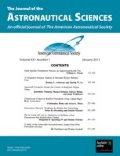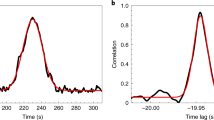Abstract
Understanding and predicting the evolving spin states of defunct geosynchronous (GEO) satellites and rocket bodies is important for space situational awareness, active debris removal, satellite servicing, and anomaly resolution. There is clear evidence that many defunct GEO satellite spin states are predominantly driven by the Yarkovsky-O’Keefe-Radzievskii-Paddack (YORP) effect. The YORP effect is spin state evolution due to solar radiation and thermal re-emission torques. Observations are crucial to understand how YORP drives spin states and to validate dynamical models. Unfortunately, GEO satellites are non-resolved from ground-based telescopes and extracting spin states (spin periods, rotational angular momentum vector, instantaneous attitude) from ubiquitous photometric light curve data is challenging. Even for well-known objects, light curve inversion often yields several or more well-fitting spin state solutions within the measurement noise and modeling uncertainty (i.e. detailed satellite geometry, reflective properties, etc.). Also, there is strong evidence that the YORP effect drives satellites from uniform rotation to non-principal axis tumbling. Such tumbling states further complicate the light curve inversion process because the motion is driven by two independent periods rather than one. To aid complete spin state analysis, particularly for the tumbling case, Doppler radar observations collected at NASA Goldstone Deep Space Communications Complex are incorporated. Observing the well-documented retired GOES 8–12 weather satellites, the radar data yielded unambiguous spin period estimates for all targets and greatly narrowed pole solutions, independent of light curve data. Significant changes in spin rates and pole directions were observed over a two month span. These findings are consistent with YORP-driven evolution.




















Similar content being viewed by others
Notes
NASA Goldstone Deep Space Communications Complex, https://www.gdscc.nasa.gov/
Jet Propulsion Laboratory Navigation and Ancillary Information Facility, https://naif.jpl.nasa.gov/naif/
References
Papushev, P., Karavaev, Y., Mishina, M.: Investigations of the evolution of optical characteristics and dynamics of proper rotation of uncontrolled geostationary artificial satellites. Adv. Space Res. 43, 1416–1422 (2009)
Cognion, R. L., Rotation Rates of Inactive Satellites near Geosynchronous Earth Orbit, Proceedings of AMOS 2014
Ryan, W. H., Ryan, E. V., Photometric Studies of Rapidly Spinning Decommissioned GEO Satellites, Proceedings of AMOS 2015
Earl, M.A., Wade, G.A.: Observations of the spin-period variation of inactive box-wing geosynchronous satellites. J. Spacecr. Rocket. 52(3), 968–977 (2015)
Benson, C. J., Scheeres, D. J., Ryan, W. H., Ryan, E. V., Cyclic complex spin state evolution of defunct GEO satellites, Proceedings of AMOS, 2018
Albuja, A.A., Scheeres, D.J., Cognion, R.L., Ryan, W., Ryan, E.V.: The YORP effect on the GOES 8 and GOES 10 satellites: a case study. Adv. Space Res. 61, 122–144 (2018)
Benson, C.J., Scheeres, D.J., Ryan, W.H., Ryan, E.V., Moskovitz, N.A.: GOES spin state diversity and the implications for GEO debris mitigation. Acta Astronautica. 167, 212–221 (2020)
Benson, C. J., Scheeres, D. J., The YORP Effect for Tumbling Defunct GEO Satellites (AAS 19–858), Proceedings of the AAS/AIAA Astrodynamics Specialist Conference, Portland, ME, 2019
Benson, C.J., Scheeres, D.J.: Averaged Solar Torque Rotational Dynamics for Defunct Satellites. Journal of Guidance, Control, and Dynamics. 44(4), (2021)
Rubincam, D.: Radiative spin-up and spin-down of small asteroids. Icarus. 148, 2–11 (2000)
Vokrouhlicky, D., Bottke, W. F., Chesley, S. R., Scheeres, D. J., Statler, T. S., The Yarkovsky and YORP Effects, in Michel, P., DeMeo, F. E., Bottke, W. F., Asteroids IV, University of Arizona Press, Tucson, AZ, pp. 509–532, 2015
Schildknecht, T.: Optical surveys for space debris. The Astronomy and Astrophysics Review. 14, 41–111 (2007)
Pravec, P., Harris, A.W., Scheirich, P., Kušnirák, P., Šarounová, L., Hergenrother, C.W., Mottola, S., Hicks, M.D., Masi, G., Krugly, Y.N., Shevchenko, V.G., Nolan, M.C., Howell, E.S., Kaasalainen, M., Galád, A., Brown, P., DeGraff, D.R., Lambert, J.V., Cooney Jr., W.R., Foglia, S.: Tumbling asteroids. Icarus. 173(1), 108–131 (2005)
GOES Decommissioned Satellites, https://www.ospo.noaa.gov/Operations/GOES/decommissioned.html,
GOES I-M Databook, Rev. 1, Aug. 31, 1996, https://goes.gsfc.nasa.gov/text/goes.databook.html,
Acknowledgements
The research was carried out at the Jet Propulsion Laboratory, California Institute of Technology, under a contract with the National Aeronautics and Space Administration (80NM0018D0004). This work was also supported by a NASA Space Technology Research Fellowship grant number NNX16AM53H. The authors would like to thank NASA Goldstone Deep Space Communications Complex for providing antenna observing time. Finally, the primary author would like to thank Razi Ahmed at the Jet Propulsion Laboratory for fruitful discussion about radar interferometry that helped inspire this research.
Availability of Data and Material
Upon request.
Code Availability
Upon request.
Funding
The research was carried out at the Jet Propulsion Laboratory, California Institute of Technology, under a contract with the National Aeronautics and Space Administration (80NM0018D0004). The primary author was also supported by a NASA Space Technology Research Fellowship grant number NNX16AM53H.
Author information
Authors and Affiliations
Corresponding author
Ethics declarations
Conflicts of Interest/Competing Interests
On behalf of all authors, the corresponding author states that there is no conflict of interest.
Additional information
This article belongs to the Special Topic Section:
Advanced Maui Optical and Space Surveillance Technologies (AMOS 2020)
Guest Editors: James M. Frith, Lauchie Scott, Islam Hussein
Publisher’s Note
Springer Nature remains neutral with regard to jurisdictional claims in published maps and institutional affiliations.
Rights and permissions
About this article
Cite this article
Benson, C.J., Naudet, C.J., Scheeres, D.J. et al. Radar and Optical Study of Defunct Geosynchronous Satellites. J Astronaut Sci 68, 728–749 (2021). https://doi.org/10.1007/s40295-021-00266-z
Accepted:
Published:
Issue Date:
DOI: https://doi.org/10.1007/s40295-021-00266-z




